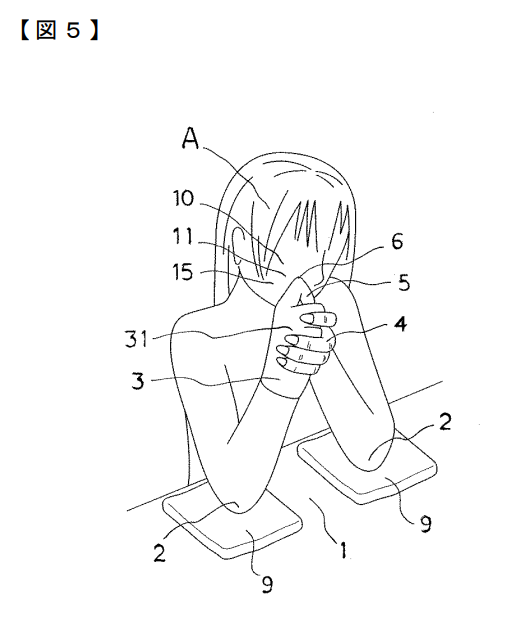
- Overview of the Patent Drawing
- Patent Insight 1: Elbow Support Mechanism Enhances Stability
- Patent Insight 2: Symmetrical Hand Position for Focused Pressure
- Patent Insight 3: Potential for Guided or Automated Training
- Patent Attorney’s Thoughts
- Keywords
- Application of the Technology: “Facial Energy Recharging Station for Expression Recovery”
Overview of the Patent Drawing
This patent drawing illustrates a facial muscle massage method, focusing on a person (labeled A) seated with both elbows resting on flat pads (2) supported by a base (1). The hands are clasped together and brought to the face in a structured manner. Numbered elements include key muscle regions of the face (10, 11, 15), facial areas of contact (5, 6), arms (3, 31), and specific contact configuration of the fingers and hands (4).
Patent Insight 1: Elbow Support Mechanism Enhances Stability
The drawing prominently features elbow support pads (2) placed on a base (1), allowing the user to stabilize their upper limbs. This configuration minimizes unnecessary motion and ensures that the pressure applied during the massage is controlled and consistent. Such an arrangement is ideal for users performing self-massage routines where precision and repeatability are critical for therapeutic effects.
Patent Insight 2: Symmetrical Hand Position for Focused Pressure
The clasped hands (4) are brought into a symmetrical position against the central area of the face (5, 6), suggesting that the massage technique involves applying inward or upward pressure toward the facial muscles (10, 11, 15). This could help stimulate blood flow, relieve tension, or tone facial muscles. The uniformity of motion enabled by this posture supports an evenly distributed pressure profile.
Patent Insight 3: Potential for Guided or Automated Training
The clearly delineated posture and placement of limbs open up potential future applications in guided massage systems. For example, integrating sensors into the pads (2) or base (1) could provide real-time feedback on posture or pressure. This could evolve into a semi-automated training system for therapeutic self-care, ensuring optimal technique for facial rejuvenation or recovery.
Patent Attorney’s Thoughts
Looking at the patent drawing for the “Facial Muscle Massage Method,” I felt a strong sense of appreciation for the thoughtfulness behind its design for self-care.
The inclusion of elbow support pads that stabilize the upper limbs is especially important for facial massage, where precise and delicate pressure is key.
By minimizing unnecessary arm movement, the system allows for consistent and controlled contact with the face — something not always easy to achieve in self-administered massage.
What also stood out to me was the symmetrical hand placement, which seems intentionally crafted to evenly distribute pressure across facial muscles.
This kind of balance likely enhances both the comfort and the effectiveness of the massage technique.
I was particularly intrigued by the potential this system holds for future development.
The way the posture and structure are clearly defined opens up possibilities for sensor integration or guided feedback.
With the right technology, even beginners could receive assistance on proper form and pressure, making effective facial care more accessible.
It’s exciting to think how this might evolve into a smart therapeutic tool in the realm of wellness and recovery.
Keywords
facial massage, self-care, muscle stimulation, symmetrical posture, elbow support, pressure control, guided therapy
Application of the Technology: “Facial Energy Recharging Station for Expression Recovery”
Purpose
Using the facial massage technique with stabilized elbow support, develop a “Facial Energy Recharging Station” for public spaces like coworking hubs or transit lounges. The system provides short sessions that “recharge” expression muscles, ideal for modern humans whose faces have gone into sleep mode.
System Components
- Elbow Stabilization Pads: Mounted on a base to support the user’s arms, enabling controlled, precise facial pressure with minimal fatigue.
- Smile Assist Handset: A custom grip guides the user to form the correct hand posture. Built-in micro-vibrators gently pulse energy into the facial muscles.
- Facial Feedback AI: Sensors analyze muscle activity and posture, giving real-time feedback like “You’re squinting too hard—try relaxing your eyebrows.”
- Reaction Mirror Display: As the massage proceeds, a mirror displays phrases like “You’re looking 12% more radiant already!” for confidence boosting.
- Expression Reset Timer: A built-in timer leads the user through phases: blank face → relaxed → gentle smile, reawakening dormant expressions.
Operational Flow
- Take a Seat: User sits at the station and places elbows on the pads, hands naturally guided into the massage posture.
- Session Start: AI greets with a warm message like “Hey there, your face looks like it skipped lunch. Let’s fix that.”
- Massage Phase: User applies guided pressure while sensors track the symmetry and effectiveness of muscle stimulation.
- Mood Animation: An animation shows glowing muscles recharging like a video game power meter.
- Session Complete: Timer ends and the system affirms: “You’re recharged and radiant. Now go make eye contact with confidence.”
This device guides users from “expressionless mode” to “socially presentable” in five minutes—perfect for anyone whose face forgot how to emote.
This article was presented at “Intellectual Property Lightning Talks #28 Extended Online Edition 2025 Spring.“- Patentsalon.com
Disclaimer: This content is an AI-generated reinterpretation based on a patent drawing.
It is provided for educational and cultural purposes only, and not as legal advice.



